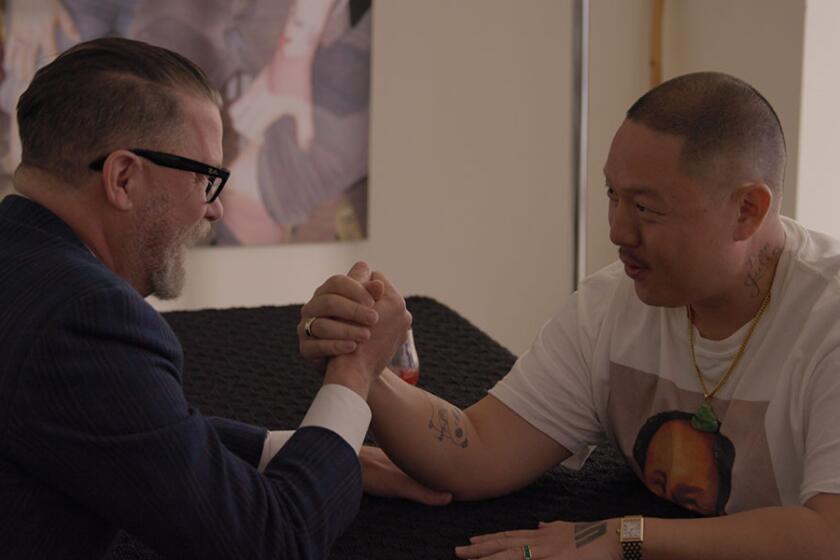‘Ballet 422’ peeks behind curtain at birth of a Justin Peck ballet
All eyes are on Justin Peck.
Only 27, the gifted New York City Ballet soloist has already choreographed 15 ballets for that company as well as the Miami City Ballet and the L.A. Dance Project since 2009. Last year, he was named resident choreographer for the New York City Ballet, only the second to hold that title in the illustrious company’s history.
------------
For the record, Feb. 13, 11:20 a.m.: An earlier version of this post described director Jody Lee Lipes’ 2010 film “NY Export: Opus Jazz” as a documentary short. It is a scripted feature.
------------
And just last week, Peck unveiled his latest piece for the New York City Ballet, “Rodeo: Four Dance Episodes.”
Peck is also the subject of a new documentary, “Ballet 422,” which opens Friday. Directed by Jody Lee Lipes, the cinéma-vérité film follows Peck over a two-month period in 2013 as he creates a new ballet, “Paz de la Jolla,” for the venerable company founded in 1948 by the influential choreographer George Balanchine and impresario Lincoln Kirstein. The troupe is now led by ballet master in chief Peter Martins, a former principal dancer with the company.
The documentary offers a behind-the-curtain look at the company as Peck, then a member of the corps de ballet, collaborates with dancers, musicians, lighting designers and costumers to bring to life “Paz de la Jolla,” NYCB’s 422nd original ballet.
Lipes, who admits that ballet is “not always something that thrills me when I watch it,” went to a presentation Peck gave for his second ballet, “Year of the Rabbit,” at the Guggenheim in 2012. Lipes’ wife, Ellen Bar, a former NYCB dancer and now director of media projects, was moderating the evening. She became the producer of the documentary.
“I was really fascinated with Justin and the way he talked about his work,” said Lipes, who worked with the ballet troupe on “NY Export: Opus Jazz,” a 2010 scripted feature about groundbreaking NYCB choreographer Jerome Robbins’ 1958 ballet.
The filmmaker recalled one moment when Peck had Tiler Peck (no relation), who is featured in “Ballet 422,” go through her solo in front of the audience. “Then he got up and corrected her and had her do it again. I was really fascinated about how he spoke to her and how clear and concise he was and how she seemed to totally understand every single thing he said.”
Lipes was struck that the then-24-year-old Justin Peck was “totally at home in the situation and totally unaware of the audience.”
“I thought, ‘He’s great for a documentary, because he’s the kind of person who doesn’t get uncomfortable or change in front of the camera.’”
After seeing the world premiere of “Year of the Rabbit,” Lipes knew that Peck was “someone who is going to have a substantial career.”
“This particular ballet was really exciting for me to watch,” Lipes said. “It would be amazing to see a film about him that was made before that amazing career happened, while he was still learning how to do his job.”
Peck, a San Diego native, started dancing when he was about 13 and began studying at NYCB’s School of American Ballet when he was 15.
“I started to go see the New York City Ballet every evening, and that is when I was exposed to really amazing dancing repertoire, especially works by George Balanchine and Jerome Robbins,” Peck said in a recent phone interview.
“I started to understand dance as it relates to music. I was always kind of interested in pursuing choreography as an artistic outlet and started making a couple of small dances when I was 20. Peter Martins noticed and invited me to work at the New York Choreographic Institute. It’s a laboratory where choreographers can go to develop their voice and experiment a bit.”
When Peck got his commission to do “Paz de la Jolla,” Lipes began filming. “We didn’t know it was going to be a feature,” Lipes said. “We shot for a couple of days, and I said, ‘This is good,’ so we kept going.”
“I was a little bit nervous and focused on the process of creating this ballet and fulfilling the commission,” said Peck. “He [Lipes] was a stealth presence. I hardly noticed him.”
Peck moved into his apartment building while they were cutting the film, Lipes said.
“I remember telling him ‘we have a rough cut I want to show you at the end of the week,’ and he was like, ‘Of what?’ ” said Lipes. “ I said, ‘The documentary.’ He said, ‘When did you do it?’ He literally didn’t know we had captured something that substantial.”
More to Read
Only good movies
Get the Indie Focus newsletter, Mark Olsen's weekly guide to the world of cinema.
You may occasionally receive promotional content from the Los Angeles Times.











